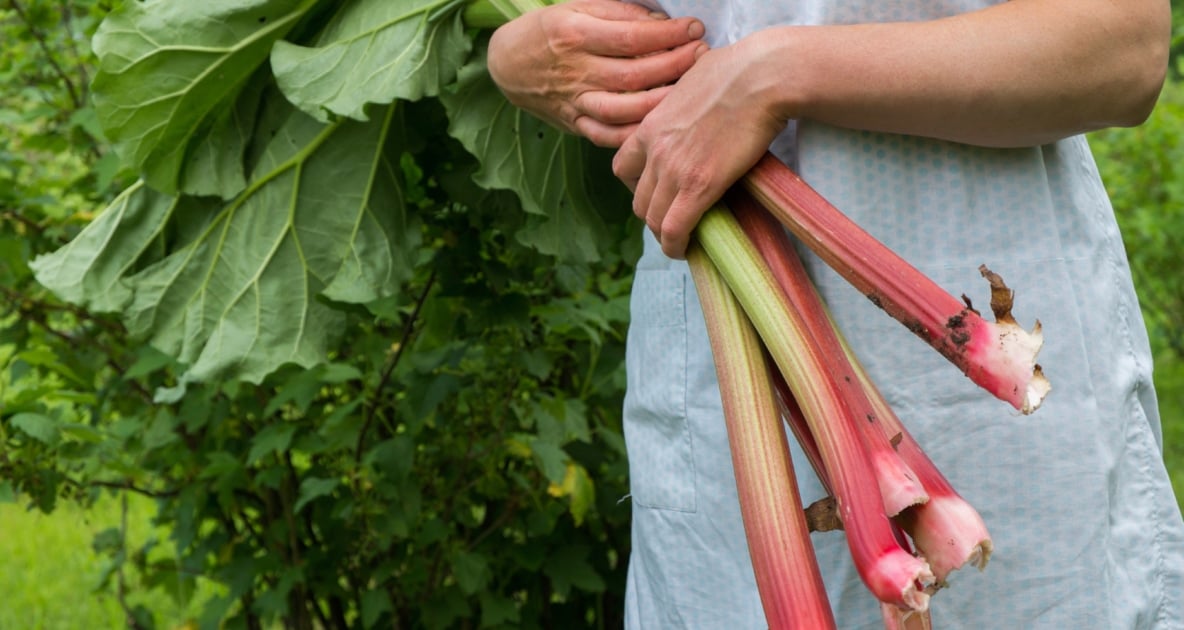Table of Contents
The Rhubarb is ready, but what is the correct way to harvest it? Wait! Is it enough to know the right way to harvest it?
Well, knowing the process is not sufficient, as the gardeners must be familiar with the right time for harvesting Rhubarb.
Rhubarb is a well-known plant for its edible leaves and stalk with a sour flavour and unique tart. The vibrant pink crimson stalks with their enormous ruffled leaves immediately catch the attention of individuals. It retains its verdant and colourful appearance from spring through October and can be picked anytime.
However, if you are harvesting the plant for the first time and wish to learn more about it, you have landed on the right page. The article will help you understand how and when to pick Rhubarb to get the most out of this crop. So, without further addition, let’s quickly dive in!
The Complete Process of Planting Rhubarb
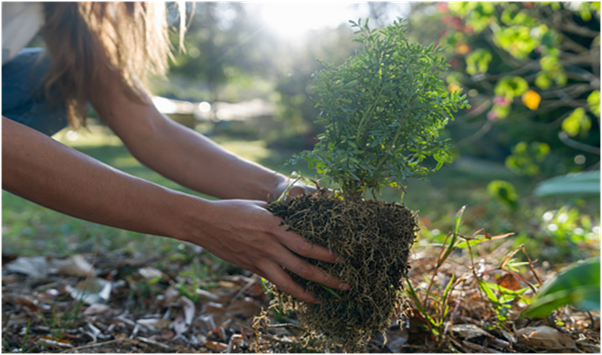
Although it thrives in full sun, Rhubarb may also be grown in low light. Pick a spot that has rich, well-drained soil because it will rot if it stays damp for too long, as it requires excellent drainage. Next, add organic material to the soil, such as compost or rotted manure. As heavy feeders, Rhubarb plants require organic material. The Rhubarb harvest is plentiful. Its mature height and width may be up to 2–3 feet. So prefer a location that won’t be overrun with people.
When Should You Plant Rhubarb
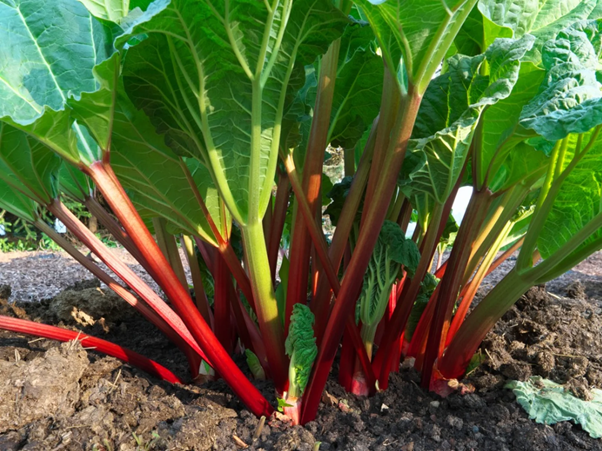
Both late autumn and early spring are good times to grow Rhubarb like Rhubarb Crown ‘Victoria’.
- The best time to plant Rhubarb crowns is in the spring when the plant has entered dormancy.
- Crowns should be planted in the spring when the soil is ready to work with. It is when the roots are still dormant and before the onset of growth. Soil temperature must be at least 50°F, as measured using a thermometer.
Basic Steps to Plant Rhubarb
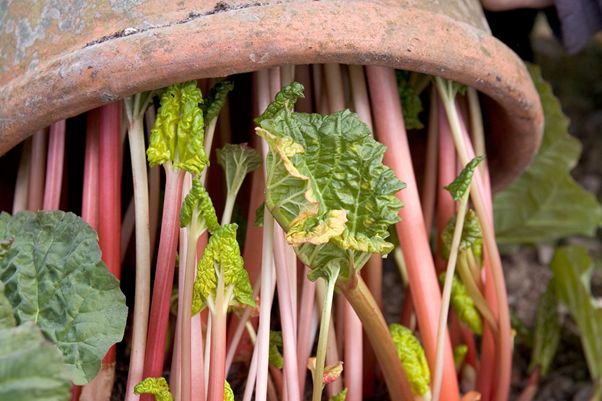
- You may getRhubarb crowns that are a year old from a garden store, nursery, or online. Both bare-rooted specimens and young plants already established in pots will be available for purchase. (You can grow Rhubarb from seeds)
- Remove any perennial weeds from the planting area before planting.
- Make larger holes, like a bushel basket.
- Plant Rhubarb with a 3- to 4-foot gap between each plant and a 3- to 4-foot gap between rows.
- With the buds pointing up, position the plant’s crown so the eyes are approximately 2 inches beneath the soil’s surface.
- Provide enough water right after planting.
Growing Process of Rhubarb
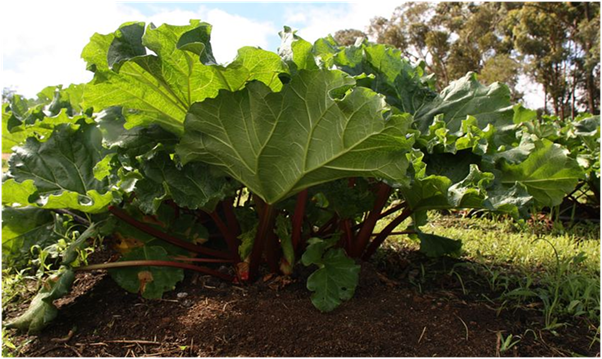
Overcrowding is a typical issue with Rhubarb and may result in poor growth. Dug out and divide the Rhubarb roots every three to four years. In early spring (or late autumn), while the plants are dormant, you should divide them. At least one big bud has to be present in each division.
- Spread a thick layer of straw mulch to prevent water loss and weed growth.
- Be sure to provide constant watering for your plant. Rhubarb such as Rhubarb Victoria Rheum requires plenty of water, particularly in dry summer.
- As soon as seed stalks emerge, remove them immediately since they just suck up the plant’s energy that might be utilised to produce stalks or roots.
- When the ground thaws in spring, lightly sprinkle a fertiliser (10-10-10). Check the frost dates in your area.
- Clear the area of any dead plants in the autumn. After the ground has frozen, cover your Rhubarb with organic mulch, ideally well-rotted compost, measuring 2 and 4 inches thick. Putting nitrogen in the soil can help the Rhubarb plants flourish in the spring.
How to Harvest Rhubarb
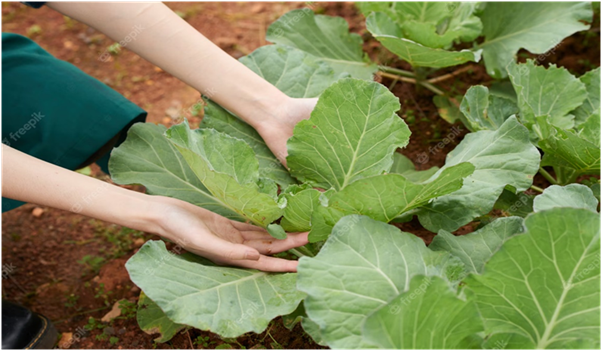
Rhubarb is a beautiful, hardy perennial used for dessert, often in pies and crumbles. It has big leaves and pink, red, or greenish leaf stalks. Typically, stems are harvested in the spring, but plants may be protected with pots to provide a crop of blanched stalks earlier, in the late winter.
As the stem matures, the sweet taste of Rhubarb flavour varies. However, the Rhubarb plant requires very little care when it comes to when to pick Rhubarb. Further, it may produce fruit for many years.
Can You Pick Rhubarb in the First Season?
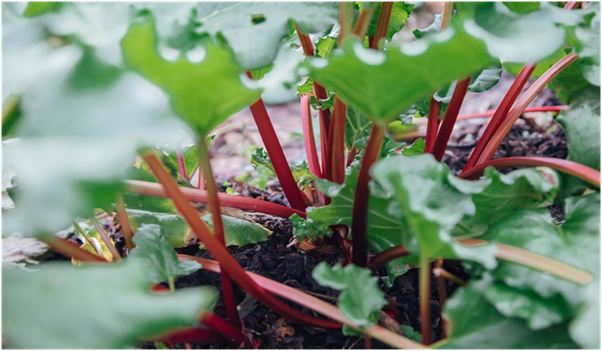
The solution to this query will vary based on your chosen technique to germinate the Rhubarb. Rhubarb may be grown from cuttings, bare roots, potted plants, or seeds, and each method has a different required time commitment for when to pick them.
- Roots Cutting: The easiest and quickest method to start with is cutting the root, sometimes known as the crown. Plants are divided by cutting off sections of their roots and replanting the resulting crowns in the late autumn or early spring. Typically, the harvest in the first year is small.
- Bare Root or Nursery Stock: You can find Rhubarb bare roots or saplings in any nursery.Neither of them should be harvested in the first year. After the first year, light harvesting is fine, and normal harvesting may resume in subsequent years.
- Seeds: Rhubarb seeds, like Rhubarb Champagne Seeds, usually mature into harvestable plants for two to three years.
Which Month Is Ideal for Rhubarb Picking
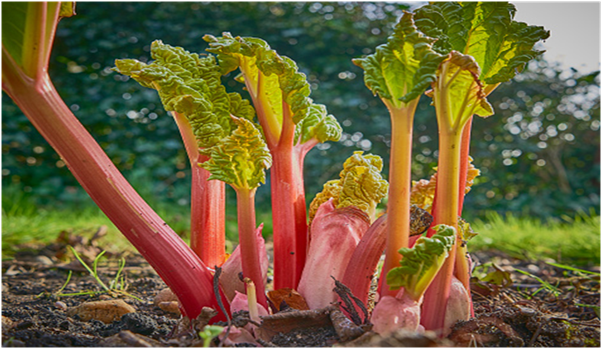
Many people get confused about when to pick Rhubarb in the UK. Hence, you are suggested to pick your Rhubarb anytime between early spring and mid-July. After this point, Rhubarb stunts growth and quality and rots in hot weather.
You may gather your Rhubarb in various ways throughout its prime growing months in spring and early summer.
- Collect stalks as required: During the growing season, gather stalks as needed in your favourite recipes. It will also aid in thinning out the plant and preventing the over-development of bigger stalks.
- Harvest the first crop: Midway through the spring, you may expect a big Rhubarb yield. However, plants may recover more rapidly if a few smaller stalks and leaves are left on the plant.
- Harvest the second crop: New leaves will emerge just a few days after your first harvest. The Rhubarb should have grown back sufficiently by early June for a second picking. This time, don’t forget to pick up any leaves. Even though the plant will grow slowly again in the summer and autumn, it will still have enough leaves to survive the winter.
If you’re fortunate, you can get in one more harvest before summer arrives. The first harvest often occurs in mid-June and the second in early to mid-July.
Is There a Particular Time In a Day to Pick Rhubarb?
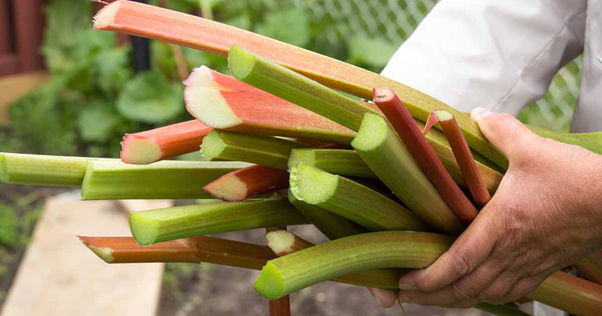
You can pick Rhubarb in the morning for some greatest effects. It is because the plants absorb water and convert stored carbohydrates into sugar throughout the night, which remains in the plant the following morning. Compared to other delicate veggies in your garden, Rhubarb plants are less prone to wilt in the heat because of their thick leaves and sturdy stalks. During the warmer months, keep the harvested stalks in the shade to prevent them from getting dry.
How to Know When Rhubarb Is Ready to Pick
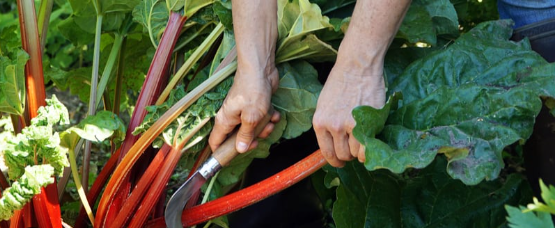
Is there any sign to know when to pick Rhubarb? Well, yes! The size of the Rhubarb stalks is the greatest indicator of when it is mature and suitable to harvest.
Checking the following can help you determine if your Rhubarb is ready to pluck or not:
- Pick the ideal size: Rhubarb’s optimal harvesting size is 30cm (12 inches) and a diameter of 1.25cm to 2.5cm (1/2 to 1 inch).
- Do not depend on colour: Rhubarb’s appearance can’t determine maturity. The colour entirely depends on the cultivars and their process. So, the colour may be dark red, green, or a hybrid of the two colours.
- Wait till there are sufficient stalks: If you want to ensure the plant recovers quickly after harvest, you must wait until it has 10 stalks. Young plants will benefit greatly, particularly those planted early in the season.
How to Pick Rhubarb Appropriately
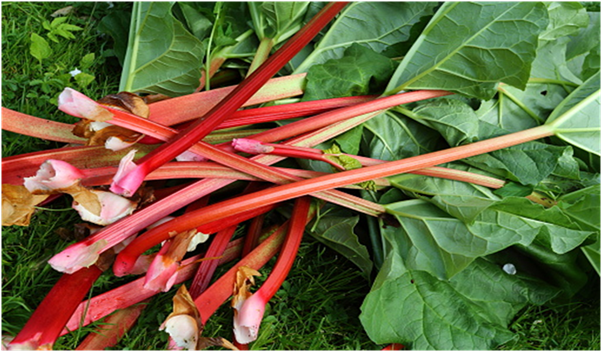
After getting an idea of when to pick Rhubarb, it is essential to know how to pick them. Therefore, you are suggested to hand-pick Rhubarb. No doubt, it may require little effort, but it gives fruitful results as well. The following are some simple instructions to harvest Rhubarb correctly.
- Get started with the tallest stalks. Then, continue with the smaller ones next.
- Keep approximately a third of the stalks on the plant at all times.
- Hold the stalk firmly as near as possible to the root. With a little pull, you can remove the majority of stalks.
- If the stalks resist tugging, try twisting the stalk as you pull. Sometimes you have to use a lot of force to get it out.
- Instead of cutting them, twist the stalks to remove them quickly. As opposed to cutting them, which leaves a stub that rapidly rots, twisting off the stalks might foster the growth of new leaves.
- Cut or twist off the leaves to get rid of them. To remove them, grab the stem below the leaf and twist. You might also try severing it with a knife or garden shears.
- To protect the soil and prevent weeds, you may either compost the leaves or use the bigger ones as mulch in your garden.
- In rare cases, a little bulb will remain at the stalk’s base after you twist it off. You may snip it off, twist it, or throw it in the compost.
- Compost should be added once the July harvest is complete. The plant may now recuperate during the summer.
- You may still pick leaves in the summer and autumn if needed.
How to Preserve and Store Your Rhubarb
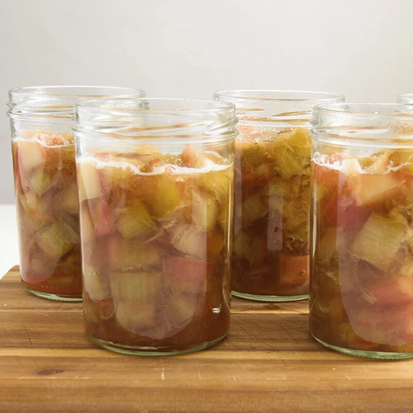
After following the right method of picking Rhubarb, make sure to store them properly. The following are some methods for preserving your harvest:
- In the refrigerator: Fresh Rhubarb may be stored in the fridge for up to four weeks. You can keep the stalks unwashed or well-dried.
- Frozen: Cut the Rhubarb into 1-cm (1/2-inch) broad pieces. An airtight container is the best to store them after they are frozen. The shelf life of frozen Rhubarb is about one year.
- Dehydrated: Cut the Rhubarb into pieces approximately 1 cm (5/8 inch) broad, then dehydrate it. Dehydrating them in the oven is another option. Sealing your Rhubarb properly will keep it for around a year.
- Canned: Several methods exist for canning Rhubarb, which may be used in various tasty dishes. Strictly follow the instructions on your canner.
Final Thoughts!
All in all, having an idea about when to pick Rhubarb is crucial if you are thinking of harvesting them. You can expect a better result with proper care and understanding of the harvesting time. If you are a vegetable garden owner, the planting process will become more effortless and quick.
Just follow the steps and tips mentioned above and plant them at the correct time. Plant your Rhubarb in full sun on soil that drains well and has a high organic matter content. Due to its high nutritional need, Rhubarb requires annual fertilizer additions in the spring and after harvest in late June. Mulch might help with soil temperature and moisture regulation.
Tender and tasty red, pink, or green Rhubarb stalks – Rhubarb Victoria Vegetable Plant Seeds are among the earliest crops to appear in the spring. The sour flavour of Rhubarb stems complements the sweetness of other fruits and sugar when baked into desserts, including pies, crumbles, cakes, and jams. It requires little maintenance and yields a lot of delicious food, making it a popular addition to vegetable gardens and decorative borders nationwide.
Is there any interesting thing about Rhubarb that you want us to know? Comment below!
Frequently Asked Questions (FAQs)
When Should You Avoid Consuming Rhubarb?
Rhubarb will show signs that will be a clear indication of the damage. Excessive low temperatures can cause damage to the stalks and leave them with weird flavour and poor texture. Hence, you must know when to pick Rhubarb UK and consume it. Rhubarb is an edible plant popular for its tart and unique flavour. However, if you have kidney disease, you must not consume them. Also, you must not consume Rhubarb once the harvest time passes. It is primarily because the plant becomes toxic after harvest time.
When Is It Inappropriate to Pick Rhubarb?
When summer arrives, put down the Rhubarb picker. In late July, higher temperatures might cause the stalks to harden into the wood, which is necessary for the plant to store energy for the next winter. People believe that once the summer season starts and harvest time is gone, the entire Rhubarb plant becomes toxic. So, you can pick as many Rhubarb stalks as you can before the harvest time. But once the harvest time passes, you must not pick Rhubarb.
How Much Rhubarb Can You Pick in a Single Sitting?
If you want your Rhubarb plants to thrive after harvesting, you shouldn’t take more than a third of each plant at a time. Instead, leave the plants alone so they may recuperate and re-grow. It is because if you pick too many stalks from a single plant, it will not survive after the harvest season. So, be mindful of how many stalks you are picking from one single Rhubarb plant.
When Will You Be Able to Harvest Rhubarb?
Rhubarb plants should be picked when they are 12 inches tall for smaller kinds and 24 inches tall for the bigger ones. The plant is edible, and many people grow them at home for personal use. However, you must learn about the harvest season of Rhubarb (which lasts up to June) and pick your Rhubarb on time. Also, remember not to pick the Rhubarb once the summer season starts.

